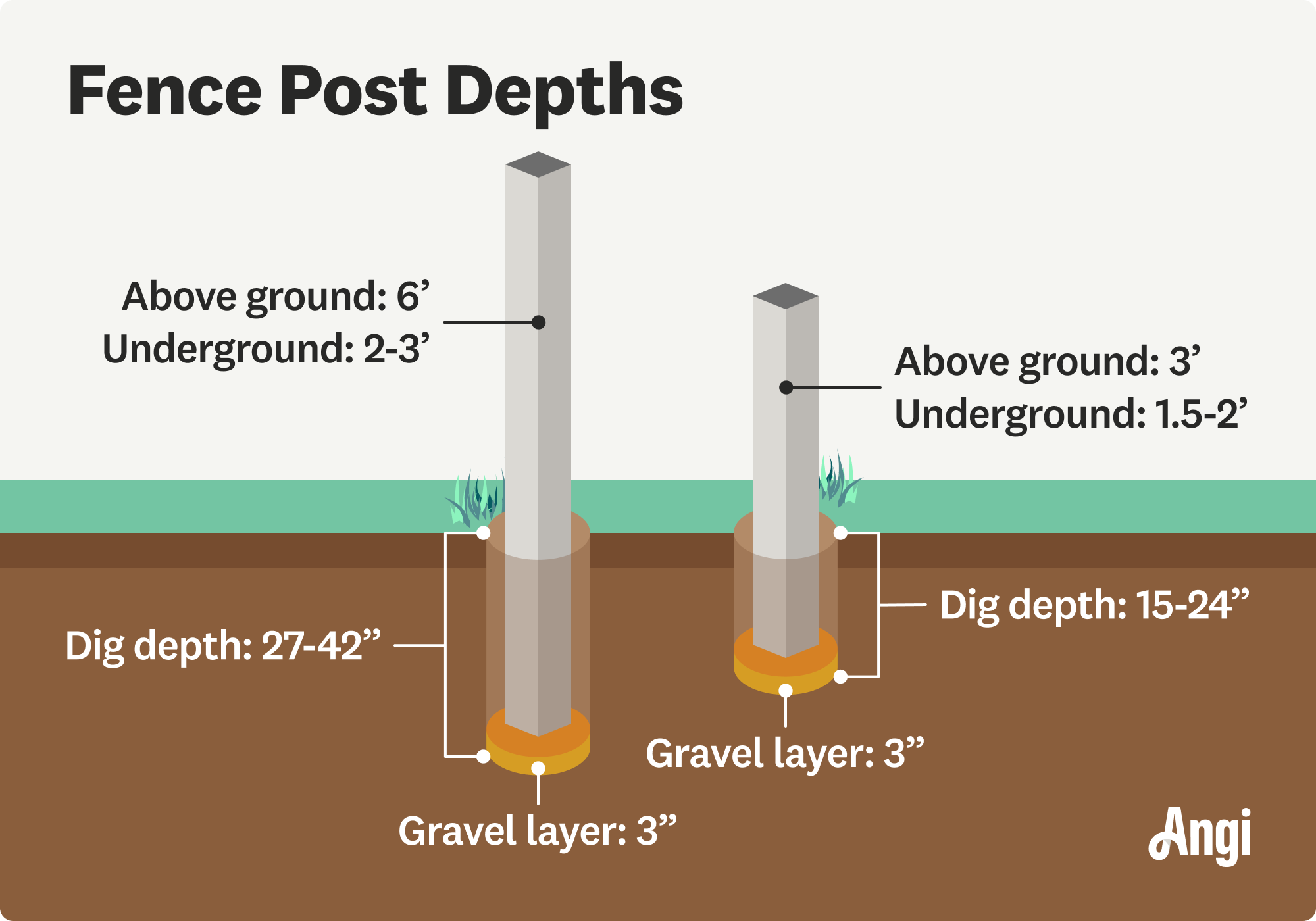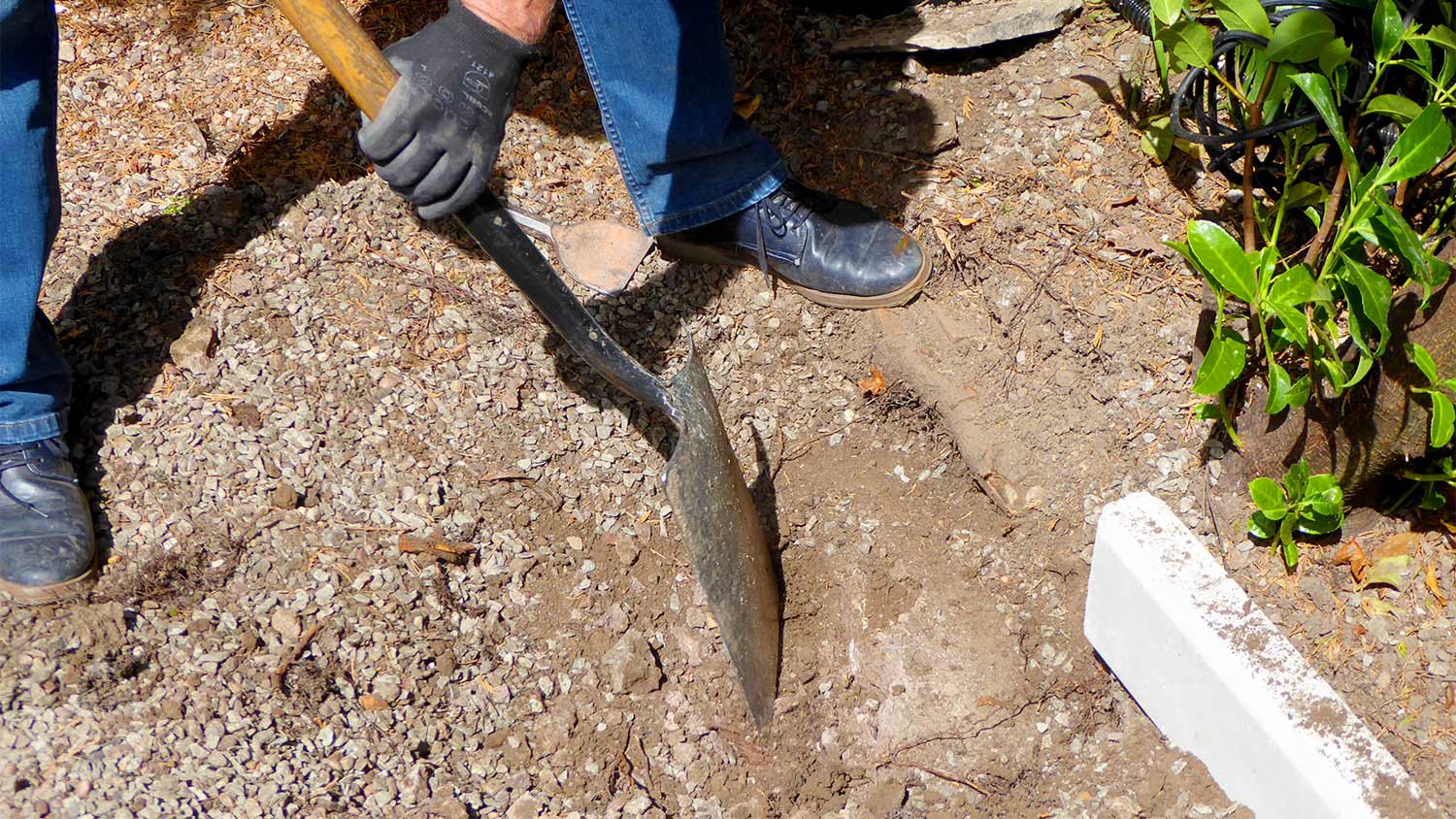
How much a privacy fence costs depends on several factors, including the size of the fence and the material used. Our cost guide breaks down these and other factors.
Finding the ideal fence post depth takes a little digging—literally


Set your fence posts deep enough to bury one-third to one-half of the aboveground height of the post.
The hole for the footing should be three times the diameter of the post.
You’ll need to dig deeper if you have unstable soil, windy weather, or you’re setting a gate post.
Your fence post hole should be a uniform width throughout, so use a power auger.
Your fence post should be buried at 1/3 to 1/2 of the height above the ground. For example, if you’re building a 6-foot fence, the underground portion of your post needs to be 2 to 3 feet. Meanwhile, the footing hole should be three times the post diameter. To keep the post hole sizes consistent, use a power auger for the digging. If you have loose soil, live in a windy climate, or need to set a gate post, you’d want to dig even deeper.

Whether you're installing a picket or panel fence post, dig your hole deep enough to accommodate one-third to one-half of the aboveground height of your fence plus 3 to 6 inches of gravel. For example, a 6-foot-tall fence should have posts buried at least 24 inches deep, plus an extra 3 inches for gravel. Here are some basic guidelines.
| Fence Height (Aboveground in Feet) | Post Hole Depth (Inches) |
|---|---|
| 3 | 15–24 |
| 4 | 19–30 |
| 5 | 23–36 |
| 6 | 27–42 |
| 7 | 31–48 |
| 8 | 35–54 |
The width—or diameter—of your post hole should be three times the diameter of your post. Standard post diameter varies based on the type of fence, so you’ll need to measure, but here are some common sizes.
| Size of Pole | Post Hole Diameter (Inches) |
|---|---|
| 2-3/8-inch round pole | 7.2 |
| 4x4-inch square pole | 12 |
| 6x6-inch square pole | 18 |
Gate posts require more stability because they have to handle the weight and movement of the gate. Dig your gate post holes deep enough to accommodate one-half of the aboveground height of your fence, plus a 6-inch layer of gravel.
| Fence Height (Aboveground in Feet) | Post Hole Depth (Inches) |
|---|---|
| 3 | 24 |
| 4 | 30 |
| 5 | 36 |
| 6 | 42 |
| 7 | 48 |
| 8 | 54 |
Fence gates are heavy and cumbersome to install. It’s all too easy to make a small mistake and ruin the integrity of your fence during a DIY installation. Hire a fencing pro to ensure a sturdy installation done right.

If you live in an area that experiences freezing temperatures, your fence will be the most stable if you position the posts below the frost line. The frost line is the depth at which groundwater freezes in the soil. The type of soil around your home, its moisture content, and average temperatures in your area all contribute to the frost line.
When you install fence posts above the frost line, the fence can be unstable due to the freezing and thaw of water in the soil. As water freezes, it expands. As it thaws, it contracts, potentially pushing the posts out of the soil.
Your local fence code will most likely contain information about the required fence post depth to avoid frost damage. If it doesn't, and freezes occur in your area, a safe bet is to set the posts at least 24 inches deep.
Finding the fence post depth takes a little basic math. You’ll need a calculator and some measuring tape. These tips can help:
Measure the height of your post, then divide the total height by two or three to get a general depth.
Burying half the pole is the sturdiest option. It’s ideal for gate posts, fences made from heavier materials, loamy or clay soil, and climates with high winds.
You can get away with burying a third of the pole if it’s a lightweight panel post and you have a sturdy soil type like sand, sandy loam, or gravel.
Don’t forget to add 3 to 6 inches to your measurement for a layer of gravel. The more gravel, the better the drainage. This is especially important for wood posts, which can rot in moisture.
Choose the right size nails for your fence pickets to prevent them from coming loose or splitting during installation. You’ll want 8d to 10d nails for setting pickets and 18d to 20d for posts.
If you don't have experience, you should enlist a fence company near you.

A properly installed fence post will last for several years, if not decades. Along with digging deeply enough and making the post hole the appropriate size, there are a few ways to fill the hole to increase stability.
Add soil and gravel: Add 3 inches of gravel to the fence post hole to improve drainage, top the gravel with soil, and tamp it all down. Add 2 to 3 inches of gravel over the soil, then let it sit for several days. Tamp it down again before installing the pickets.
Pour in concrete: Mix the concrete according to instructions and pour it into the post hole. To prevent water damage, apply silicone caulk between the post and concrete after the concrete dries.
Apply expanding foam: Foam and concrete similarly help stabilize a fence post, but foam takes less time to set and cure. This option is best for lighter fences, such as those made from vinyl or mesh. Mix and apply the foam according to the package’s directions.
It's pretty easy to tell if a fence post isn't buried deeply enough. The post may be loose and easily moved. It may also start to lean, pulling the rest of the fence with it. Also, the bottom of your post needs to be set below the frost line. Otherwise, you will get frost heave over time and your post will eventually get pushed out of the ground after a frost due to soil contraption and movement.
You can reset a fence post if it wasn't installed correctly the first time. If the post was installed to the correct depth, you can fix any leaning or wobbliness by adding more soil around the post.
Another option is to dig out around the posts and pour concrete into the hole to create a stronger base. If the posts are rotted or otherwise damaged, your best option may be to pull them up and replace them.
Fence installation is not the most difficult DIY project, especially if you can find an experienced helper and live in an area that does not require a fencing permit. Typically, it’s a two-to-three-day job to build a fence, including any time you might need for post footings to set depending on the material. You can also install a no dig fence by yourself fairly easily.
However, we still recommend you to hire a pro if you’re building a taller privacy fence, or simply don’t want to deal with the time and labor. An experienced fence contractor ensures your new fence is properly installed and can handle all utility marking and permitting requirements. Generally, professional fence installation costs $1,856 to $4,750.
Tomy's team is top-notch! They replaced my old opener with a quiet, modern one. The whole process was smooth and hassle-free
Mayflower was an excellent choice for the complete renovation of my condominium. They knew exactly how to deal with the complexities of the condo building and management to make the project very smooth, easy and done right. From start to finish, everyone was incredibly helpful and their...
Reliable, trustworthy, efficient! I canâ t say enough about how pleased I am with the service this company offers. Highly recommend!
Alex and his crew are great! I contracted them to move my dad and they went above and beyond!
My experience with this company did not start off 5 stars, but it certainly ended that way. Sam reached out to me and showed me that All Complete Construction does care about their customers. He listened to my complaints, understood my frustration, and went above and beyond to make it right....
Great service, great price, very knowledgeable.
Excellent sales staff and installer. Easy to work with. I appreciated that my current system was able to be activated and used.
We purchased a home that was need of a bit of work and I had great difficulty finding good firms that charged fair prices and performed well. I first hired JMZ to clean the yard and cut the grass. I saw Jose's truck in the area and called the number on the side. In the past two years Jose and...
What a nice job. Roger the foreman was kind to me and made my life easier. Their availability is 24/7. The Customer service department provided status without having to ask for it. I would definitely recommend their service to my friends.
Superior was great in every detail. Easy to make/change an appointment, the inspector (John Connor) was prompt, friendly, and very informative. We thought some holes in a fence post was caused by termites, but John inspected it along with some other areas of the house and told us we did not...
From average costs to expert advice, get all the answers you need to get your job done.

How much a privacy fence costs depends on several factors, including the size of the fence and the material used. Our cost guide breaks down these and other factors.

The cost to install a picket fence varies by height, material, labor, and more. Read this guide to help you budget for a picket fence installation.

Installing a redwood fence costs around $6,300, though several factors, such as size, landscaping, and permits, can impact the price.

A fence is a great way to add privacy and style to your yard. Compare two common options, horizontal vs. vertical fences, to see which is right for you.

Get the facts on the cost of invisible fence repair, including average prices, key cost factors, and tips to save. Learn what impacts your repair estimate and how to budget.

Discover gate hinge types for every need—T hinges, barrel hinges, butt hinges, and more—and learn how to choose the best hinge for your project.